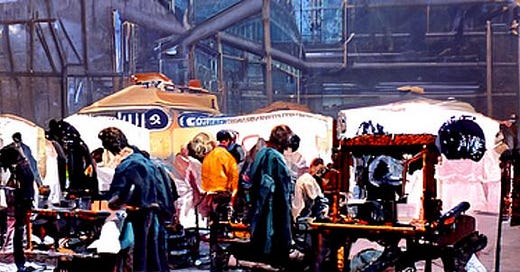In the conclusion of Iain McGilchrist’s book The Master and His Emissary, the question is asked, “What would the left hemisphere’s world look like?” if the left hemisphere of the brain “became so far dominant that, at the phenomenological level, it managed more or less to suppress the right hemisphere’s world altogether”.
In this series of posts I’d like to break down his conclusion and discus just how closely our world is conforming to the left hemisphere’s perspective.
Part #1 Part #2 Part #3 Part #4 Part #5
Berger and colleagues1 emphasise that consciousness changes its nature in a world geared to technological production. It adopts a number of qualities which again are clearly manifestations of the world according to the left hemisphere, and therefore in such a world technology could be expected to flourish and, in turn, further to entrench the left hemisphere’s view of the world - just as bureaucracy would be both a product of the left hemisphere and a reinforcement of it in the external world. In a society dominated by technology, Berger and colleagues predict what they refer to as: ‘mechanisticity’, which means the development of a system that permits things to be reproduced endlessly, and enforces submergence of the individual in a large organisation or production line; ‘measurability’, in other words the insistence on quantification, not qualification; ‘componentiality’, that is to say reality reduced to self-contained units, so that ‘everything is analysable into constituent components, and everything can be taken apart and put together again in terms of these components’; and an ‘abstract frame of reference’, in other words loss of context. The philosopher Gabriel Marcel speaks of the difficulty in maintaining one’s integrity as a unique, individual subject, in a world where a combination of the hubris of science and the drive of technology blots out the awe-inspiring business of conscious human existence, what he refers to as ‘the mystery of being’, and replaces it with a set of technical problems for which they purport to have solutions. He warns that in such circumstances we would be too easily persuaded to accept the role thrust upon us, to become an object, no longer a subject, and would connive at our own annihilation. (Iain McGilchrist, The Master and His Emissary)
For those readers new to this series I’d like to reiterate that this picture McGilchrist is painting is the summation of hundreds of pages of analysis of the nature of the left hemisphere and what the left hemisphere’s world would look like. It is easy to think, compelling even, that McGilchrist has just looked at the world today and dictated a case study from such observations. But what is stunning is the pure correlation between the left hemisphere’s phenomenological being in the world, its drive to shape the world in a certain manner, and the reality we find ourselves in today. You might say it’s obvious, nothing stunning about it at all, but that’s always the notion after the fact, isn’t it? McGilchrist hasn’t looked at the status quo and then come up with a story of why it’s so - he has built a solid case, from the ground up, as to the potentiality of a left hemisphere world, and then held that up against what we observe today. And so it happens the theory and the reality seemingly match incredibly well. Frightening even, as we have not yet seen the fullness of a world according to the left hemisphere unbridled by the right.
This paragraph, in particular, describes the heart of a world created by the left hemisphere. A world manufactured in such a way that positive feedback loops ensure the further deepening and propagation of a mechanistic system that the left hemisphere not only understands but is fully convinced is the only way. Let’s look at some of the components mentioned here:
MECHANISTICITY: The development of a system that permits things to be reproduced endlessly, and enforces submergence of the individual in a large organisation or production line. Of course the production line has been around since the industrial revolution started and we’ve seen this taken to great heights of efficiency with people and machines in the 20th Century. The individual a “cog” in the machine, ultimately to be replaced by actual cogs and not humans at all. This is the dream of the so called “Fourth Industrial Revolution” where machines, smart ones, replace humans, so the system can produce more, faster, for longer, for cheaper, forever. Mechanisticity is being applied to everything that produces anything - because volume, speed, efficiency, trump any notion of humanity being involved in the process (unless the notion of humanity is useful from a marketing perspective, but it will only be the notion that is utilised, the actual manufacture will be by intelligent machine). Human being is not an important part of production output and is seen as a liability for the most part. The utility of the individual is in the programming, the initial design, the setting in motion, but beyond that the individual is likely to just be in the way. And even the programming, the design, the setting in motion, is ideally done by an intelligent machine.
MEASURABILITY: The insistence on quantification, not qualification. We’ve touched on this in previous posts, but here it is again as a core attribute of the left hemisphere’s ideal world. Quantification is primary because it can be represented as numbers, a complete abstraction, and thus easily manipulated and controlled, or so it seems. The qualitative is not so, it can be vague, awkward, open to interpretation, even intangible which is rather intolerable to the left hemisphere. It it can’t be reduced to a number sequence to be ingested by a machine, or an algorithm to drive a machine, then it’s unlikely to be of any use, according to the left hemisphere. (I’m assuming McGilchrist use of the word qualification as indicating the nature or characteristics of a thing, as opposed to the more modern usage meaning adequate skills for a particular task.)
COMPONENTIALITY: Reduced to self-contained units; analysable into constituent parts; components that can be disassembled and reassembled; abstracted from any context. Here is the great deception of the left hemisphere - that all things are discrete things assembled to make more complex things and just as easily disassembled into simpler things. The continuous and non-linear flow of life (where there are no discrete things) is replaced with the mechanistic cause and effect linear perception of a grand machine (for a detailed look at this go to Are You A Machine?). Context is lost, or rather ignored, because it’s too complex (and often too complicated) and unable to be quantified (because it’s complexity necessitates a qualitative appreciation rather than a quantitative definition) and difficult to abstract for any utility. And what I mean here is that to comprehend the broadest context of say the firing of a neuron, would embrace the neurochemical, electrical, electromagnetic activity of all the near-field cells, and further out the same activity of the entire nervous system, and the hormonal system, and the influence of all the symbiotic microbiota, toxins, free radicals… and you can see how un-quantitative it can quickly become. So to isolate the firing neuron from its context is to better quantify it in order to understand its mechanisms. This may be useful in some circumstances, and indeed necessary in many areas of understanding how things work. But the propensity of the left hemisphere is to apply this approach to all things, all the time, about everything. And so the universe is seen as the grand machine that can be understood only by breaking it down to its component parts and reassembling it from those components. In fact this is so part of our education system that most will argue that indeed the universe is a complex machine - not a metaphor, but actually. We have been indoctrinated that even the organic is a machine - the book “The Blind Watchmaker” by Richard Dawkins, in an attempt to explain complexity through natural selection, uses the machine metaphor as representative of life. I won’t say any more on this as it is well covered in Are You A Machine?.
And so finally what of the sentiment of Gabriel Marcel? I’d have to agree with him wholeheartedly that we need to be on guard against being persuaded that we are just objects and no subjects, and thus our humanity annihilated. We should do all in our power to maintain our uniqueness as individual subjects who are un-quantifiable yet have many beautiful qualitative aspects to be celebrated. We should remain a mystery to the machine - even the very ‘intelligent’ ones. The technocrats think you can be completely defined and knowable by reducing you to an array of quantifiable variables (a bunch of numbers), and therefore able to be abstracted to an object of utility - able to be controlled and used.
This is not just philosophical musing for intellectual entertainment - this is about the reality of our life right now. The digital ID, the social credit system, the mass vaccinations, mass lockdowns, hyper-surveillance, all the mechanisms of control over an individual’s ideals, ideas and freedoms, all stem from “a world geared to technological production” and the perspective of the left hemisphere.
As McGilchrist says, the left hemisphere is a wonderful servant but a terrible master. Which is why we cannot let that vocal part of ourselves, that sees only in part, betray the silent part that sees the whole.
Over to you - what are you seeing?
The Homeless Mind: Modernization and Consciousness (by Berger, Berger & Kellner)






Share this post